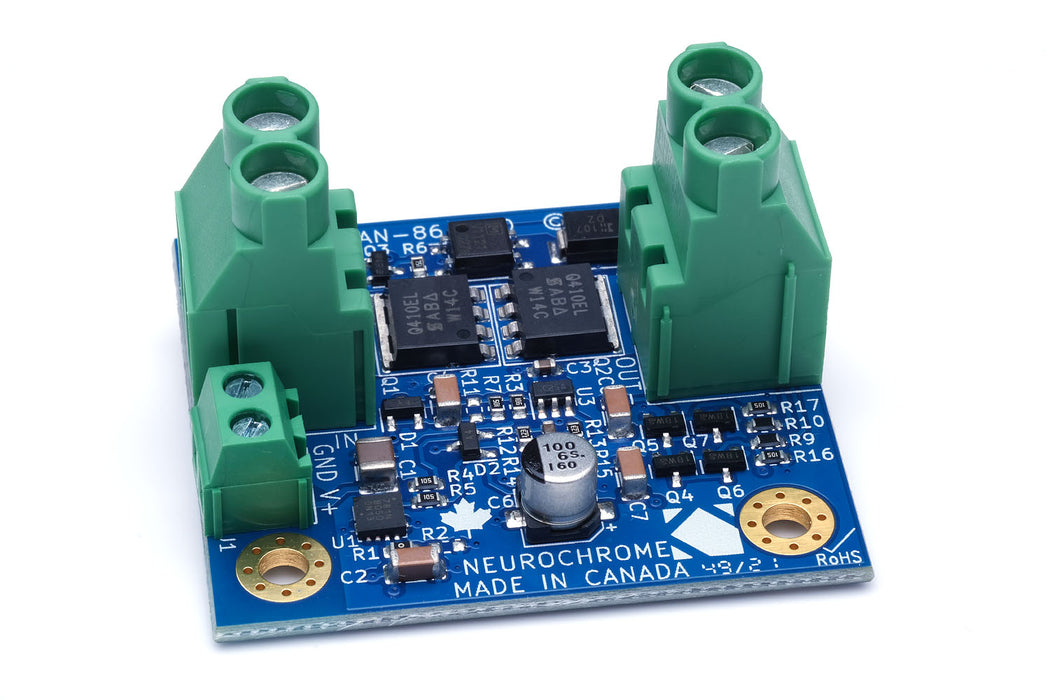-
The Guardian-86 is powered by the same power supply as the power amplifier. It will operate on any supply voltage in the range of +12 V to +90 V, thus, will work well with any amplifier powered by ±12 – ±90 V. This wide power supply range is supported without the need for modifications or adjustments. The Guardian-86 is literally plug-n-play.
The Guardian-86 will enable the speaker connections five seconds after the power has been applied. This eliminates clicks and pops on start-up.
During normal operation, the Guardian-86 continuously monitors the power supply voltage to determine the nominal supply voltage. The Guardian-86 will disable the speaker connections when the supply voltage drops below approximately 2/3 (67 %) of the nominal voltage, thereby minimizing thumps on power-down.
The Guardian-86 will disconnect the speaker if the amplifier outputs more than ±1 V DC, thereby protecting your speakers in the event of catastrophic amplifier failure. This DC voltage threshold was chosen following a thorough analysis of the reaction time, complexity, and reliability of the protection circuit along with an analysis of the failure modes of audio power amplifiers.
All this is accomplished without adding any measurable distortion. The Guardian-86 provides consistent, state-of-the-art performance through all of its service life.
The Guardian-86 circuit module is designed, manufactured, and assembled in Canada.

-
The features of the Guardian-86 are listed below.
- Compatible with single-ended output as well as bridged/BTL output amplifiers.
- Fully assembled module.
- Mono construction.
- Compatible with any audio power amplifier operating at a supply voltage of ±12 V to ±90 V (or single-ended amplifiers operating at +12 V to +90 V). This includes all the Neurochrome Modulus amplifiers and Class D amps such as the Hypex NC500 and Purifi 1ET400A.
- Needs no additional power supply. The Guardian-86 is powered by the same power supply as the power amplifier. It draws only 6 mA of supply current.
- No relays! All switching is done with MOSFETs for the lowest distortion.
- No relay contacts to wear, thus, no change in performance due to aging.
- Adds no measurable distortion.
- Floating photovoltaic MOSFET driver ensures consistent good performance throughout the full swing of the output signal.
- The output is enabled after a 5-second delay on power-up.
- Continuous tracking of the power supply voltage determines the nominal supply voltage. Output is disabled when supply voltage falls below 67 % of the nominal supply voltage.
- Input and output: Terminal blocks accepting up to AWG 10 (5.2 mm2) wire.
- 1.75 × 1.55 inch (45 × 40 mm) footprint. The assembled board is approximately 1.05 inch (27 mm) in height.
- Gold plated circuit board. Designed and manufactured in Canada.
-
The key specifications for the Guardian-86 are tabulated below.
| Parameter |
Value |
Notes |
Power Supply Voltage
|
12 – 90 V |
|
Current Consumption
|
6.0 mA |
|
Dimensions & Weight
|
45 × 40 × 27 mm
20 g
|
|
The connections between the Guardian-86 and a typical audio amplifier are shown below.
-
A speaker protection circuit consists of a switch, a switch driver, and a DC detection circuit.
The main design challenge of a speaker protection circuits is the design of the switch itself. The switch must be able to handle low voltages with high fidelity and be able to switch the large output current. These requirements are in conflict as the low-voltage switching tends to be best accomplished by gold switch points, but those points will vaporize if they are used at the high current levels commonly found in audio amplifiers. While it is possible to design a relay with two contact sets in parallel – one optimized for low voltage the other for high current – a much more elegant solution is to use a solid-state switch, such as a MOSFET.
Using a MOSFET switch solves another issue with relays: Arcing. When the relay switch contacts open at high currents, a plasma arc forms. Such an arc can destroy the switch completely. Even in nondestructive cases, the arc will cause the contact surfaces of the relay to wear resulting in a slow degradation of the switch itself. Thus, when used to protect a speaker in a hifi system, the relay wear will cause the sound quality to slowly degrade over time. Using a solid-state switch avoids the arcing, hence the contact wear associated with the switch commutation. This ensures good performance of the protection circuit throughout the full service life of the circuit.
Yet another issue with relays is that some of them cause distortion and in some cases this distortion can be significant. Thus, a better solution is to use a solid-state switch, such as the MOSFETs used in the Guardian-86. However, for a MOSFET to provide good performance as an audio switch, it must be biased in a way that minimizes the variation in switch resistance throughout the signal swing. In the Guardian-86, this is accomplished by using a floating photovoltaic gate driver, thereby minimizing any distortion contributed by the switch.
The DC voltage detector in the Guardian-86 is a simple pair of NPN bipolar transistors. This simple and reliable detector ensures that the Guardian-86 will disable the output in the event of a catastrophic amplifier failure.
-
The plot below shows the distortion before (blue) and after (purple) the Guardian-86 when used with an ultra-low distortion amplifier. The sharp jumps in the curve are caused by the range switching of the APx555B audio analyzer.





